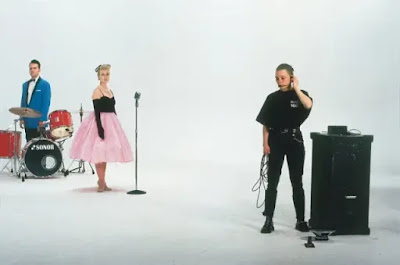
The work is challenging because it doesn't fit into the neatly arranged categories that we give art and visual culture today. Coleman's work characteristically occupies the interface between still and moving images. He also plays with the relations between photograph and cinema, art history and cinema, and more recently, the spectacular visual culture of advertising, television, fashion photography and police imaging. Known for his use of transparent images projected through multiple stacked slide carousels, sometimes accompanied by audio tracks that don't describe what's in the image, Coleman's signature works are also about the tension between image and word. We are sure to come away wondering about the efficacy of words and images as modes of communication.
 |
| James Coleman, Retake with Evidence, 2007 |
In one piece at the beginning, Harvey Keitel stands on a stage, intermittently backgrounded by a plain white stage, archaeological ruins, monumental columns, antique sculptures that might be in a museum. Keitel delivers a monologue from Sophocles that is about as impenetrable as the Greeks get. Keitel is not preened and prissed for the camera, but wears a sweatshirt and perspires under the lights. Sophocles text is focussed on questions of social violence and democracy, but it's the contexts and modes of presentation that draw our focus. Issues of performance, staging, frustration of viewer expectations through fragmentation and repetition are brought to the fore. Even if they don't watch the entire performance, viewers will understand they are watching their own process of watching.
 |
| James Coleman, La Tache Aveugle, 1978-1990 |
Also towards the beginning is a signature Coleman slide projection with synchronised audio, Slide Piece. The voice describes the most important aspects of the image before us: a drab, nondescript square in Milan. Each time the slides move past the light source, a new description begins. But the image is the same, even if it is a new slide. And the audio simply describes different aspects of this same drab square, honing in on what might be important to different viewers. Over time, our eyes will have moved around the image having noticed a window above the awning, the pylon behind the cars, and other innocuous details. The work gives the idea that what is in the image depends on who is looking, and what's important to that viewer.
 |
| James Coleman, Charon (MIT Project), 1989 |
In other works, such as Charon, the slides are self-conscious performances of the way that moving images are constructed. Even if the images are not moving. Thus in Charon, a synchronised audio tells stories about the people who are in the image, but again, the slides don't fully correspond to the stories we hear. However, there are just enough details—the presence of a child, a hotel room, a window, a fancy outfit—to keep our desire for a sound/image link alive. Unlike the construction of narrative desire that promises an ending, here it is the promise of audio that goes with the image before us. Again, we are faced with images about the frustrations of viewing the moving image, even if we look at still images. Likewise, a piece such as Charon thrusts the difficulty of an image's communication into the foreground. We are made aware of all the elements that aid (and ultimately manipulate) our understanding and consequent interpretation. We start to become cognisant of the influence of things like the title, the descriptions, the uses to which the image is put, who takes the photographs, who directs the set, who dresses the models.
 |
| James Coleman, (Documenta 11 Project), 2002 |
In a work such as (Documenta 11 Project), Coleman removes the title altogether. Thus, we are left looking at some kind of transient shape in the light that is presumably moving slower than the human eye can perceive it. And we have no idea of what we are looking at because he has removed the title. That said, the work has a title, even if it has been untitled: it is given (Documenta 11 Project) as title. The work was commissioned for Documenta 11 by Okwui Enwezor in 2002, a Documenta that had its unique identity. Coleman's work in turn takes on that identity. In other words, we are never left to fall into the illusion of the works.
 |
| James Coleman, Still Life, 2013-2016 |
Even when illusion motivates the representation, we are confronted with the exposure of inauthenticity. In Still Life, Coleman plays with the French translation of dead nature. The poppy has been pulled out of the ground, thus destroyed, and is re-animated by Coleman's camera when the flower makes minuscule movements. The piece is projected on the black wall without a sound. Given the looping of audio tracks in other works, the silence of Still Life is itself somehow frustrating. So used to playing games with the audio/image relations, it's difficult to stand still and watch the flower which may or may not be real, in absolute silence.
 |
| James Coleman, Lapsus Exposure, 1992-1994 |
All Images courtesy Marian Goodman Gallery © James Coleman
No comments:
Post a Comment